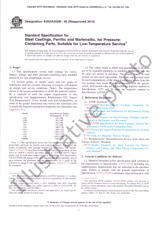We need your consent to use the individual data so that you can see information about your interests, among other things. Click "OK" to give your consent.
ASTM D7997-21
Standard Practice for Polyurethane Raw Materials: Gel Tests for Polyurethane Non-Foam Formulations
Translate name
STANDARD published on 15.1.2021
The information about the standard:
Designation standards: ASTM D7997-21
Publication date standards: 15.1.2021
SKU: NS-1029209
The number of pages: 7
Approximate weight : 21 g (0.05 lbs)
Country: American technical standard
Category: Technical standards ASTM
The category - similar standards:
Annotation of standard text ASTM D7997-21 :
Keywords:
gel time, isocyanate, polyol, polyurethane, raw material, resin blend,, ICS Number Code 83.080.10 (Thermosetting materials)
Additional information
| Significance and Use | ||
|
5.1?General Utility:? 5.1.1?This practice is suitable for research, quality control, specification testing and process control. 5.1.2?It is useful to define and verify the reactivity of non-foam polyurethane formulations. 5.2?Limitations:? 5.2.1?Operator-to-operator variability and lab-to-lab variability can be significant. 5.2.2?The variability of this practice is dependent on the equipment used to measure the gel time. It is recommended that the testing laboratory and the client agree on the equipment and the conditions to be used that include the following: 5.2.2.1?Gel Tester and gel point criteria, 5.2.2.2?Speed/rpm of the mixer, 5.2.2.3?Type and shape of the mix blades, 5.2.2.4?Size and type (for example, shape, lined or unlined) of container for mixing the components and for measuring the gel time, and 5.2.2.5?The volume (or height) of material to be placed in the container for measuring the gel time and the depth of the measuring wire or spindle of the gel tester from the bottom of the container. 5.2.3?Users of this practice shall develop their own precision data to determine if these procedures meet their requirements. 5.2.4?It is possible that low-levels (ppm, ppb) of contaminants will not be detected using this practice. |
||
| 1. Scope | ||
|
1.1?This practice covers procedures for determining the gel times of polyurethane non-foam formulations using commercially available gel test equipment. 1.2?Definitions, terms, and techniques are described along with procedures for calculating sample weights. 1.3?The values stated in SI units are to be regarded as standard. 1.4?This standard does not purport to address all of the safety concerns, if any, associated with its use. It is the responsibility of the user of this standard to establish appropriate safety, health, and environmental practices and determine the applicability of regulatory limitations prior to use. Note 1:?There is no known ISO equivalent to this
standard.
1.5?This international standard was developed in accordance with internationally recognized principles on standardization established in the Decision on Principles for the Development of International Standards, Guides and Recommendations issued by the World Trade Organization Technical Barriers to Trade (TBT) Committee. |
||
| 2. Referenced Documents | ||
|



 Cookies
Cookies
